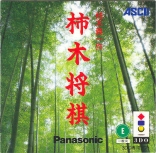Kakinoki Shogi

Kakinoki Shogi
Description
Kakinoki Shogi
Menu/Command Translation
Use the following actions.
- Left, Right, Up, Down: Move cursor
- RS: Changes sides/promotion (Edit Mode)
- A: Select, put
- B: Cancel, back up
- C: In-play Menu
Rules
Shogi is basically the Japanese version of chess, andthe modern form was developed in the sixteenth century. It isplayed on a 9x9 square board, and each player starts with 20 pieces:1 King, 2 Gold Generals, 2 Silver Generals, 2 Horses (Knights),2 Incense Chariots, 1 Diagonal Mover (Bishop), 1 Flying Chariot(Rook), and 9 Foot Soldiers (Pawns). The pieces look like flattenedobelisks pointing toward the enemy, with their names written onthem in Japanese characters. Many pieces' moves are somewhat similarto chess, but there are several differences. Golds move like aKing, but not diagonally backward. Silvers move into one of theforward three squares or two diagonally backward ones. IncenseChariots move like Rooks, but only straight forward. Knights moveas in chess, but only to one of the two possible forward squares.Pawns move and capture one square directly ahead.
There are two additional rules not found in chess. The first ispromotion, which is indicated by flipping a piece over. Pawns,Incense Chariots, Knights, and Silvers can be promoted to Goldsany time they enter, move in, or leave enemy territory (the backthree ranks). Bishops and Rooks can also be promoted, and gainthe ability to move one square in the directions they normallycan not (orthagonally for Bishops, diagonally for Rooks). Theother rule is that you own the enemy pieces that you capture andcan put them back in the game to fight for you. Instead of makinga normal move, you can drop a captured piece on the board. Piecesdrop unpromoted. Pawns, Knights, and Incense Chariots cannot bedropped toward the back of the board where they could not makeany further moves. Also, you cannot drop a Pawn on a file thathas another of your unpromoted Pawns on it, and you cannot dropa Pawn to give checkmate.
ASCII's Kakinoki Shogi is a good 3DO implementation of the game(Kakinoki is the last name of the game's director). You can playagainst another human, against an adjustable AI, or watch twoAI's. There are several game options, including spoken comments,displaying what moves the AI is considering, and time-limitedplay. You can save your game to resume later and display the movesbackward and forward. Computer hints are available, and you canset up the board any way you want, or solve checkmating problems.The graphics are simple, but effective, including three nice woodgrainboards.
Kakinoki Shogi needs 16% of your SRAM (~5K) to save configurationand game information. If you do not have enough free upon firstloading the game, you will have an opportunity to use the built-in(Japanese) memory manager. If you ever want or need to deletethe file, its name is ASCII_KAKINOKIJ.

